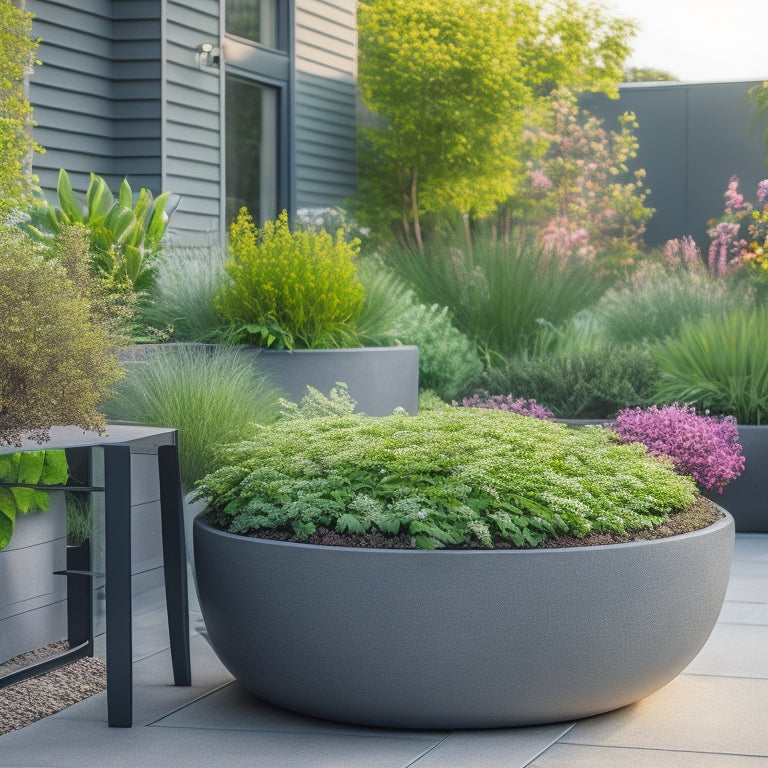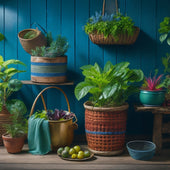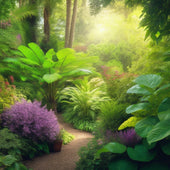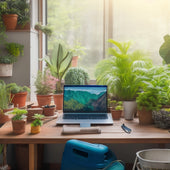
3 Creative Planter Box Design Ideas Using Concrete
Share
You can bring industrial chic to your outdoor space with cinder block planters, stacking them to create a rustic, vertical garden that maximizes space and promotes drainage. Alternatively, transform utilitarian structures into lush features with concrete block wall planters, incorporating decorative caps and built-in irrigation systems. Or, get creative with decorative block planters, alternating colors and directions to showcase vibrant displays in limited spaces. As you explore these design ideas, you'll discover endless possibilities for turning ordinary spaces into thriving gardens, and uncover the perfect blend of form and function to elevate your outdoor oasis.
Key Takeaways
• Cinder block planters offer a rustic, industrial-chic aesthetic and allow for drainage and aeration between blocks.
• Stacking concrete blocks creates vertical gardens, ideal for maximizing outdoor space and supporting climbing plants like ivy or clematis.
• Decorative caps conceal soil and enhance visual appeal in concrete block wall planters, which can also feature built-in irrigation systems.
• Alternating block directions or colors adds visual interest to concrete block planters, while varying block hues create colorful displays.
• Gaps between blocks can be filled with bright flowers or foliage to add pops of color to decorative block planters.
Cinder Block Planter Box Design
You can create a rustic, industrial-chic planter box by stacking cinder blocks to form a rectangular or square shape, leaving space in between for drainage and aeration. This design is perfect for vertical gardening, allowing you to maximize your space while adding a touch of urban charm to your outdoor area.
As you build your planter box, consider adding a trellis or a lattice to provide support for climbing plants like ivy or clematis.
For a functional and beautiful herb garden, plant a variety of herbs like basil, rosemary, and thyme in each section of the planter box. The gaps between the cinder blocks will provide ample air circulation, promoting healthy root growth and preventing waterlogged soil.
You can also add a layer of landscape fabric or weed barrier to prevent weeds from growing up through the blocks.
With a little creativity, your cinder block planter box can become a thriving oasis in your backyard, perfect for cooking up a storm or simply enjoying a rejuvenating outdoor space.
Concrete Block Wall Planters Ideas
Building a concrete block wall planter transforms a utilitarian structure into a lush, verdant feature that adds depth and visual interest to your outdoor space.
By stacking concrete blocks, you'll create a vertical garden that's perfect for urban gardening. You can use a single row of blocks to create a low wall or stack them to create a taller feature. Add some decorative caps to the top of the blocks to conceal the soil and create a clean finish.
To add some visual interest, you can alternate the direction of the blocks or create a pattern with different colors of blocks. Make sure to leave space between the blocks for drainage and aeration. You can also add some built-in irrigation system to make maintenance easier.
Decorative Block Planters for Gardens
Stacking decorative blocks in a creative pattern transforms your garden into a vibrant oasis, where colorful blooms and lush foliage spill over the edges of the planter, creating a visually stunning display.
You can create a unique vertical garden by stacking blocks of varying heights, allowing you to showcase multiple plants at once. This design idea is perfect for small gardens or urban spaces, where space is limited.
To add visual interest, incorporate color accents by using blocks in different hues or textures. For example, you can alternate between grey and beige blocks to create a striking contrast.
You can also add a pop of color by inserting plants with bright flowers or leaves into the gaps between the blocks.
Frequently Asked Questions
Can I Use Colored Concrete for a Unique Planter Box Design?
You're wondering if you can add a pop of color to your planter box design using colored concrete.
Absolutely! You can experiment with various colored concrete techniques to achieve a one-of-a-kind look.
Try mixing and matching creative color combinations, like warm terracotta and soothing sage, or bold crimson and deep indigo.
The result will be a stunning, Instagram-worthy planter box that showcases your personal style and adds a splash of personality to your outdoor space.
How Do I Seal Concrete Planters to Prevent Water Damage?
As you carefully craft your concrete creation, don't let water woes wash away your hard work.
To shield your planter from moisture mayhem, you'll need to master waterproofing techniques.
Explore sealant options like silane-based or acrylic coatings, which will form an impermeable barrier against water's wrath.
Apply a thin layer, ensuring complete coverage, and let it cure to create a watertight wonder.
Are Concrete Planters Suitable for Indoor or Outdoor Use Only?
You're wondering if concrete planters are suitable for indoor or outdoor use only.
Well, here's the deal: you get the best of both worlds!
Concrete planters thrive indoors, where they can add an industrial touch to your space and benefit from controlled humidity.
Outdoors, they showcase their durability, resisting harsh weather conditions and extreme temperatures.
Can I Add a Drainage System to My Concrete Planter Box?
Imagine a lush rooftop garden in Manhattan, where a clever DIYer installed a concrete planter box with a built-in drainage system.
You can do the same! To guarantee your plants thrive, you'll want to add a drainage solution to prevent waterlogged soil.
Incorporate a layer of small rocks or broken pottery at the bottom of your planter, then add a waterproof membrane and a drainage hole.
Regular planter maintenance will be a breeze, and your plants will thank you.
How Long Does It Take to Build a Concrete Planter Box From Scratch?
When you commence building a concrete planter box from scratch, you'll need to allocate sufficient construction time.
Depending on the size and complexity of your design, it can take anywhere from a few hours to several days.
Material considerations, such as preparing the site, mixing and pouring concrete, and allowing it to cure, will impact the overall timeline.
You'll need to factor in drying times, too, so plan accordingly to guarantee a sturdy and beautiful finished product that meets your vision.
Conclusion
You've explored three creative planter box design ideas using concrete, from cinder block planters to decorative block gardens.
Now, imagine a modern backyard featuring a 10-foot-long concrete block wall planter, adorned with lush greenery and colorful flowers, creating a beautiful focal point.
This stunning visual display not only adds aesthetic appeal but also provides a functional space for entertaining or relaxation, showcasing the versatility of concrete planter boxes in outdoor design.
Related Posts
-

7 Creative Upcycled Planter Tutorials to Try Now
Get ready to transform your outdoor space with these 7 creative upcycled planter tutorials! Start by turning cinder b...
-

7 Creative Upcycled Planter Tutorials to Try Now
Get ready to transform your outdoor space with these 7 creative upcycled planter tutorials! Start by turning cinder b...
-

7 Creative Upcycled Planter Tutorials to Try Now
Get ready to transform your outdoor space with these 7 creative upcycled planter tutorials! Start by turning cinder b...
-

7 Creative Upcycled Planter Tutorials to Try Now
Get ready to transform your outdoor space with these 7 creative upcycled planter tutorials! Start by turning cinder b...
-

7 Creative Upcycled Planter Tutorials to Try Now
Get ready to transform your outdoor space with these 7 creative upcycled planter tutorials! Start by turning cinder b...
-

7 Creative Upcycled Planter Tutorials to Try Now
Get ready to transform your outdoor space with these 7 creative upcycled planter tutorials! Start by turning cinder b...
-

7 Creative Upcycled Planter Tutorials to Try Now
Get ready to transform your outdoor space with these 7 creative upcycled planter tutorials! Start by turning cinder b...
-

7 Creative Upcycled Planter Tutorials to Try Now
Get ready to transform your outdoor space with these 7 creative upcycled planter tutorials! Start by turning cinder b...
-

7 Creative Upcycled Planter Tutorials to Try Now
Get ready to transform your outdoor space with these 7 creative upcycled planter tutorials! Start by turning cinder b...
-

7 Creative Upcycled Planter Tutorials to Try Now
Get ready to transform your outdoor space with these 7 creative upcycled planter tutorials! Start by turning cinder b...
-

7 Creative Upcycled Planter Tutorials to Try Now
Get ready to transform your outdoor space with these 7 creative upcycled planter tutorials! Start by turning cinder b...
-

7 Creative Upcycled Planter Tutorials to Try Now
Get ready to transform your outdoor space with these 7 creative upcycled planter tutorials! Start by turning cinder b...
-

7 Creative Upcycled Planter Tutorials to Try Now
Get ready to transform your outdoor space with these 7 creative upcycled planter tutorials! Start by turning cinder b...
-

7 Creative Upcycled Planter Tutorials to Try Now
Get ready to transform your outdoor space with these 7 creative upcycled planter tutorials! Start by turning cinder b...
-

7 Creative Upcycled Planter Tutorials to Try Now
Get ready to transform your outdoor space with these 7 creative upcycled planter tutorials! Start by turning cinder b...
-

7 Creative Upcycled Planter Tutorials to Try Now
Get ready to transform your outdoor space with these 7 creative upcycled planter tutorials! Start by turning cinder b...
-

7 Creative Upcycled Planter Tutorials to Try Now
Get ready to transform your outdoor space with these 7 creative upcycled planter tutorials! Start by turning cinder b...
-

7 Creative Upcycled Planter Tutorials to Try Now
Get ready to transform your outdoor space with these 7 creative upcycled planter tutorials! Start by turning cinder b...
-

7 Creative Upcycled Planter Tutorials to Try Now
Get ready to transform your outdoor space with these 7 creative upcycled planter tutorials! Start by turning cinder b...
-

7 Creative Upcycled Planter Tutorials to Try Now
Get ready to transform your outdoor space with these 7 creative upcycled planter tutorials! Start by turning cinder b...
-

7 Creative Upcycled Planter Tutorials to Try Now
Get ready to transform your outdoor space with these 7 creative upcycled planter tutorials! Start by turning cinder b...
-

7 Creative Upcycled Planter Tutorials to Try Now
Get ready to transform your outdoor space with these 7 creative upcycled planter tutorials! Start by turning cinder b...
-

7 Creative Upcycled Planter Tutorials to Try Now
Get ready to transform your outdoor space with these 7 creative upcycled planter tutorials! Start by turning cinder b...
-

7 Creative Upcycled Planter Tutorials to Try Now
Get ready to transform your outdoor space with these 7 creative upcycled planter tutorials! Start by turning cinder b...
-

5 Tips for Shaded Area Gardening Success
To turn your shaded areas into thriving gardens, start by selecting shade-tolerant crops like leafy greens and herbs,...
-

5 Tips for Shaded Area Gardening Success
To turn your shaded areas into thriving gardens, start by selecting shade-tolerant crops like leafy greens and herbs,...
-

5 Tips for Shaded Area Gardening Success
To turn your shaded areas into thriving gardens, start by selecting shade-tolerant crops like leafy greens and herbs,...
-

5 Tips for Shaded Area Gardening Success
To turn your shaded areas into thriving gardens, start by selecting shade-tolerant crops like leafy greens and herbs,...
-

5 Tips for Shaded Area Gardening Success
To turn your shaded areas into thriving gardens, start by selecting shade-tolerant crops like leafy greens and herbs,...
-

5 Tips for Shaded Area Gardening Success
To turn your shaded areas into thriving gardens, start by selecting shade-tolerant crops like leafy greens and herbs,...
-

5 Tips for Shaded Area Gardening Success
To turn your shaded areas into thriving gardens, start by selecting shade-tolerant crops like leafy greens and herbs,...
-

5 Tips for Shaded Area Gardening Success
To turn your shaded areas into thriving gardens, start by selecting shade-tolerant crops like leafy greens and herbs,...
-

5 Tips for Shaded Area Gardening Success
To turn your shaded areas into thriving gardens, start by selecting shade-tolerant crops like leafy greens and herbs,...
-

5 Tips for Shaded Area Gardening Success
To turn your shaded areas into thriving gardens, start by selecting shade-tolerant crops like leafy greens and herbs,...
-

5 Tips for Shaded Area Gardening Success
To turn your shaded areas into thriving gardens, start by selecting shade-tolerant crops like leafy greens and herbs,...
-

5 Tips for Shaded Area Gardening Success
To turn your shaded areas into thriving gardens, start by selecting shade-tolerant crops like leafy greens and herbs,...
-

5 Tips for Shaded Area Gardening Success
To turn your shaded areas into thriving gardens, start by selecting shade-tolerant crops like leafy greens and herbs,...
-

5 Tips for Shaded Area Gardening Success
To turn your shaded areas into thriving gardens, start by selecting shade-tolerant crops like leafy greens and herbs,...
-

5 Tips for Shaded Area Gardening Success
To turn your shaded areas into thriving gardens, start by selecting shade-tolerant crops like leafy greens and herbs,...
-

5 Tips for Shaded Area Gardening Success
To turn your shaded areas into thriving gardens, start by selecting shade-tolerant crops like leafy greens and herbs,...
-

5 Tips for Shaded Area Gardening Success
To turn your shaded areas into thriving gardens, start by selecting shade-tolerant crops like leafy greens and herbs,...
-

5 Tips for Shaded Area Gardening Success
To turn your shaded areas into thriving gardens, start by selecting shade-tolerant crops like leafy greens and herbs,...
-

5 Tips for Shaded Area Gardening Success
To turn your shaded areas into thriving gardens, start by selecting shade-tolerant crops like leafy greens and herbs,...
-

5 Tips for Shaded Area Gardening Success
To turn your shaded areas into thriving gardens, start by selecting shade-tolerant crops like leafy greens and herbs,...
-

Must-Have Tools for Building Block Planters Online
When building block planters online, you'll need essential tools to guarantee a sturdy and visually appealing structu...
-

Must-Have Tools for Building Block Planters Online
When building block planters online, you'll need essential tools to guarantee a sturdy and visually appealing structu...
-

Must-Have Tools for Building Block Planters Online
When building block planters online, you'll need essential tools to guarantee a sturdy and visually appealing structu...
-

Must-Have Tools for Building Block Planters Online
When building block planters online, you'll need essential tools to guarantee a sturdy and visually appealing structu...
-

Must-Have Tools for Building Block Planters Online
When building block planters online, you'll need essential tools to guarantee a sturdy and visually appealing structu...
-

Must-Have Tools for Building Block Planters Online
When building block planters online, you'll need essential tools to guarantee a sturdy and visually appealing structu...
-

Must-Have Tools for Building Block Planters Online
When building block planters online, you'll need essential tools to guarantee a sturdy and visually appealing structu...
-

Must-Have Tools for Building Block Planters Online
When building block planters online, you'll need essential tools to guarantee a sturdy and visually appealing structu...
-

Must-Have Tools for Building Block Planters Online
When building block planters online, you'll need essential tools to guarantee a sturdy and visually appealing structu...
-

Must-Have Tools for Building Block Planters Online
When building block planters online, you'll need essential tools to guarantee a sturdy and visually appealing structu...
-

Must-Have Tools for Building Block Planters Online
When building block planters online, you'll need essential tools to guarantee a sturdy and visually appealing structu...
-

Must-Have Tools for Building Block Planters Online
When building block planters online, you'll need essential tools to guarantee a sturdy and visually appealing structu...
-

Must-Have Tools for Building Block Planters Online
When building block planters online, you'll need essential tools to guarantee a sturdy and visually appealing structu...
-

Must-Have Tools for Building Block Planters Online
When building block planters online, you'll need essential tools to guarantee a sturdy and visually appealing structu...
-

Must-Have Tools for Building Block Planters Online
When building block planters online, you'll need essential tools to guarantee a sturdy and visually appealing structu...
-

Must-Have Tools for Building Block Planters Online
When building block planters online, you'll need essential tools to guarantee a sturdy and visually appealing structu...
-

Must-Have Tools for Building Block Planters Online
When building block planters online, you'll need essential tools to guarantee a sturdy and visually appealing structu...
-

Must-Have Tools for Building Block Planters Online
When building block planters online, you'll need essential tools to guarantee a sturdy and visually appealing structu...
-

Must-Have Tools for Building Block Planters Online
When building block planters online, you'll need essential tools to guarantee a sturdy and visually appealing structu...
-

Must-Have Tools for Building Block Planters Online
When building block planters online, you'll need essential tools to guarantee a sturdy and visually appealing structu...
-

Must-Have Tools for Building Block Planters Online
When building block planters online, you'll need essential tools to guarantee a sturdy and visually appealing structu...
-

Must-Have Tools for Building Block Planters Online
When building block planters online, you'll need essential tools to guarantee a sturdy and visually appealing structu...
-

Must-Have Tools for Building Block Planters Online
When building block planters online, you'll need essential tools to guarantee a sturdy and visually appealing structu...


